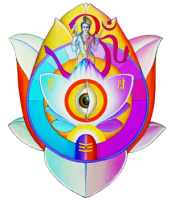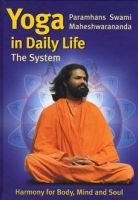Exercises for the Āgyā Chakra
Breathing Practice for the Clarification and Resolution of Problems
In order to be able to resolve a problem, no matter what type, there is one thing of primary importance – RELAX. To relax means to expand, to unite. Those who are unable to relax are also unable to meditate. Therefore relaxation is a prerequisite for approaching a problem that we would like to resolve with a clear head, intuition and the wisdom of the heart.
A simple and quick way to relax is through concentration on the breath. For this, bring your attention to the process of breathing and the spreading of the breath outside the body. Inhale clarity and pure light into the whole body, and relax the body with a long, complete exhalation. Then hold the breath for a short while – for as long as is comfortable – until the impulse to inhale occurs spontaneously. Release yourself from all negative thoughts and problems, and expand your consciousness into infinity.
- With the inhalation imagine: “I inhale the entire Cosmos – everything exists within me”
- With the exhalation think: “ I exhale the Cosmos – the entire creation comes from me”
- With the retention of the breath: “I am everywhere. Everything exists within me, and I am also everything that exists outside of me. I am one with everything”
Trātaka - Concentration on a Point or on the Flame of a Candle
Place a candle in front of you – about an armlength away and at shoulder height. Sit comfortably in a meditation pose and close your eyes. After a few minutes of inwardly composing yourself and relaxing, open your eyes and look at the candle flame. Concentrate on the tip of the brightest part of the flame. Gaze for approximately one minute (no longer) at the flame – during this do not blink – and then close your eyes again. If your eyes water it doesn’t matter – it is a purification. Should your eyes start to burn and become painful then look at the candle for a shorter period of time.
If your gaze at the candle was completely motionless an image of the flame appears in your inner space (Chidākāsha) when you again close your eyes. If this does not happen, relax and try again after a few minutes. Gaze at the flame altogether three times for about one minute each time; after each time close your eyes and observe your inner space and the reflection of the flame for about 4-5 minutes. Practise this meditation on a candle each evening before sleeping.
Trātaka is an excellent practice for purification of the eyes, frontal sinuses and nasal sinuses, quietening thoughts, promoting the ability to concentrate and relax, developing clear thinking and intuition, and awakening the Āgyā Chakra.
CAUTION: At the beginning Trātaka should only be performed under the instruction of a Yoga teacher. For very introverted people, as well as those who are inclined towards depression, hallucinations or Schizophrenia, Trātaka should not be practised.
Introversion means that the emotions are predominantly directed inward, and in extreme cases are completely suppressed. When the energy of the emotions is blocked it results in various physical or psychic disturbances. It can be that the emotions are “frozen” and solidify as apathy, or are self-destructively turned against one’s own consciousness as depression or Schizophrenia.
There is also inner Trātaka that is performed without a candle. When a flickering white flame appears in front of the inner eye, this is an indication that the energy in the Sushumnā Nādī has begun to flow. When a blue or red-orange light appears the energy is flowing increasingly in either the Idā or Pingalā Nādī.
Further Exercises that work specifically on the Āgyā Chakra
- Nādī Shodhana Prānāyāma (Purification of the Nervous System)
- Bhūmi Pād Mastakāsana (Head and Feet on the Earth)
- Yoga Mudrā (Forward Bend Sitting on Heels)
- Shashankāsana (The Hare)
- Shirshāsana (Headstand)
- Nāda Sanchalana (Sound Exercise, eg singing OM)
- Kapāla Bhāti Prānāyāma (Purification of the Frontal Sinus)
- Ākāshī Mudrā (Looking to the Sky)
Shambhāvi Mudrā (Mudra of Lord Shiva)
From beneath half-closed eyes look towards the tip of your nose. At the same time concentrate on the normal breath.
Khecharī Mudrā
Roll the tongue backwards until (ideally) the tip of the tongue touches the soft palate. Through Khecharī Mudrā both extremities, Mūlādhāra and Āgyā Chakras, are united. Khecharī Mudrā helps to control the emotions, strengthens concentration and has a direct influence on the Kundalinī.
Bhramarī Prānāyāma
Sit in a comfortable and erect meditation pose. Close both ears with the thumbs and place the index fingers on the closed eyes. The middle fingers lie loosely on the sides of the nose; the ring fingers and little fingers lie above and below the lips and close the mouth. Deeply inhale and hold the breath inside briefly. Now press the sides of the nose slightly and allow the breath to slowly flow out with a loud humming sound. Repeat this exercise seven times, one after the other. Then remain for about 10-15 minutes in the meditation pose breathing normally . Close the ears again and support the elbows on the knees or on the Pranayama Stick. Concentrate on your inner space and listen to the inner sound.
Ātmā Chintana and Manana
ĀTMĀ CHINTANA is pondering over the fundamental questions about life: “Who am I? From where did I come? Where will I go? What purpose do I have? What is the goal of my life?
In the Āgyā Chakra we receive the answer to these questions:
TAT TVAM ASI, SO HAM – That is you (Ātmā). That (Ātmā) am I.
The river ends as soon as it flows into the ocean. It dissolves in the ocean, not the ocean in it. When the Realised One dwells in the Supreme Consciousness, it is like a drop in the ocean – one with Brahman, the Supreme. The Realised One identifies with the Ātmā – “I am that – SO HAM”.
This is the essence of the philosophy of non-duality (Advaita) of which the great thinker and Saint, Srī Shankarāchārya, is the best-known advocate. He said: “Recognise yourself in all beings.” In our unity with everything existing we recognise our unity with the Supreme Self.
MANANA means reflection – to patiently and unwaveringly reflect and deliberate. Manana protects us from thoughtless, rash actions, words and decisions, and from uncontrolled emotions. Allow ourselves time, because only when the fruit is ripe does it have taste. Things performed in haste often go in an unintentional direction. Remove the weeds from your inner garden with Viveka and Bhakti and – when the time is ripe – pass the flowers and fruit that you have planted onto others.


